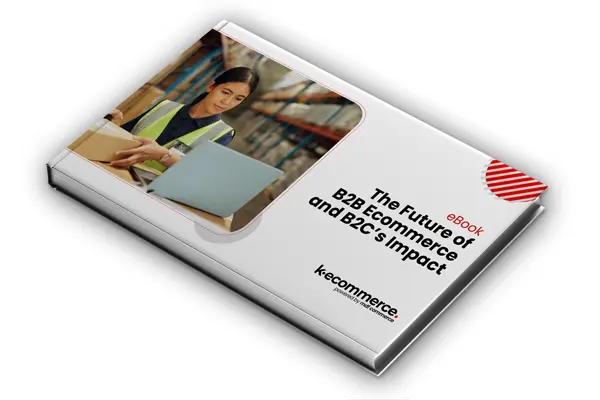
Top B2B Ecommerce Pricing Strategies for Your Business

Marketing Team
k-ecommerce
B2B buying is an expensive process, with budgets ranging anywhere from a few hundred to in excess of millions of dollars. That’s why B2B ecommerce pricing is an important concept that allows you to accommodate clients of all budgets.
However, pricing a B2B ecommerce product or service is complex. Pricing your B2B ecommerce product by adding all your costs and your desired profits doesn’t take into account the buyer’s perspective. If you want to maximize profits and create a good brand image, you need to adopt a suitable B2B ecommerce pricing strategy that’s a win-win for everyone.
In this guide, we’ll discuss why B2B pricing strategies are important and look at some of the best pricing models you can choose for your business.
Why Pricing Strategies are Necessary in B2B Ecommerce
 B2B buyers spend a lot of time researching product options and considering various factors. There’s no spur-of-the-moment purchase, and the buying decision is made over the course of several weeks to months. For over 30% of B2B buyers, the average sales cycle lasts between one and three months.
B2B buyers spend a lot of time researching product options and considering various factors. There’s no spur-of-the-moment purchase, and the buying decision is made over the course of several weeks to months. For over 30% of B2B buyers, the average sales cycle lasts between one and three months.
However, B2B buyers also want to make sure they are researching only those products that fit their budget, so pricing becomes one of the first factors they consider. In fact, 79% of B2B buyers specifically look for pricing as the top information considered in B2B purchases.
A well-planned B2B ecommerce pricing strategy gives you better chances of penetrating the initial research phase and taking your leads further into the sales funnel.
Common B2B Ecommerce Pricing Strategies
There’s no single way to price your B2B ecommerce product. In fact, many businesses use a combination of pricing strategies.
Your brand has its own product and target customer base. You need to choose a pricing strategy that accommodates the unique requirements of your business. Here are some practical B2B ecommerce pricing strategies you can apply, along with pros and cons for each.
Competitive Pricing
Competitive pricing is one of the most common B2B ecommerce pricing strategies. You analyze the pricing offered by competitors and choose a price based on that information. Usually, brands try to keep the price as low as possible to get an advantage over other companies, and they often use an average of the pricing from other brands in the industry.
This strategy is a good way to break through customers’ initial pricing filters, but it doesn’t consider the product’s features.
Pros
- Competitive pricing doesn’t depend on too many factors, making it simple to plan and implement. Leads who are price-sensitive might be attracted to your product offering.
- With the cost of B2B products making a considerable impact on the final decision of 40% of buyers, you can generate a significant number of sales.
Cons
- The only differentiation in competitive pricing is the low cost of the product. If a competitor manages to beat your strategy by offering a lower price point or a discount, customers might be quick to switch.
- Offering a low price also decreases the profit margins. If there’s any oversight in calculating the product’s actual cost, competition-based pricing might lead to losses.
- Attracting leads based on price undermines the value of the product. If you want to establish an authoritative or premium B2B ecommerce brand, there may be better strategies than competitive pricing.

Dynamic Pricing
In dynamic pricing, the product price is flexible and changes depending on your leads’ industry, requirements, and budget. Instead of a fixed, upfront pricing that’s accessible on your website or social media accounts, dynamic pricing is decided only after interacting with leads.
When a lead reaches out for a quote, you can collect the necessary information, such as the company size and revenue, to offer a customized quote.
Pros
- Dynamic pricing works well for products with a wide target audience with different company sizes, use cases, and budgets. You can quote a price depending on each customer’s specific requirements instead of taking a one-size-fits-all approach.
Cons
- While dynamic pricing accommodates a larger customer base, 51% of B2B enterprise buyers want transparent pricing. If your website doesn’t display an estimate or at least a price range, buyers may not consider your products during research.
A quick workaround for customer reluctance to this strategy is offering a website price calculator on your website to provide a rough estimate based on selected inputs and then give a call to action for more details.
Number-Based Pricing
If your product relies on how many users there are, such as a certain number of employee accounts or client profiles, number-based pricing may work best for you.
Using this B2B ecommerce pricing strategy, you can predetermine the cost of onboarding each account or adding each client profile. When customers state their requirements, calculate the total cost considering the predetermined user numbers.
For example, you can set the product price for companies with 2-10 members, companies with 10-50 members, and companies with up to 100 members. For anything above that, you can ask companies to reach out for custom pricing.
Pros
- This pricing approach is suitable for B2B ecommerce businesses that target companies of all sizes — from one-person teams to large enterprises. If you offer bulk discounts, it can help attract a higher number of large-scale businesses.
Cons
- Smaller businesses may find your product expensive if you’re incentivizing larger user sets. If your product offers features that aren’t useful to smaller businesses, they might be unwilling to invest in a brand that caters to a large-scale business audience.
Customer-based pricing
In a B2B business, customer segments can vary widely based on the volume, value, and timing of purchases. Customer-based pricing helps you cater to these segments by personalizing the price for each customer type.
For example, you could apply a bulk discount to the pricing for a customer who places large purchase volumes. Similarly, a buyer who purchases your products every quarter can be offered incentives for continued frequent repeat purchases.
However, such custom pricing doesn’t need to apply only to sales volumes. They can also apply to customer groups of varying sizes, including groups of just one buyer. You can display pricing personalized to individual buyers or buyers who are part of a larger team from the same company.
Pros
- Each customer segment gets tailored pricing that fits their buying patterns and needs.
- Customer-based pricing helps improve customer loyalty, by helping meet the client’s needs.
- You can also personalize the B2B ecommerce customer experience with a customer-based pricing approach.
Cons
- There are not many cons of customer-based pricing. However, you need to analyze customer and purchase data in depth to properly segment customers and display accurante prices.
A reliable B2B ecommerce software, like k.ecom, can help with personalizing and displaying the prices to each customer segment.
Packaged Pricing
Packaged pricing is a logical B2B ecommerce pricing solution that plays on the idea of grouping items. If you offer multiple products or product extensions, you can group complementary products and price them as a bundle.
For example, buyers who are looking for ecommerce website designing tools may also want web hosting and website security. You can create a bundle of these products and services and price them with a discount.
Pros
- With packaged pricing, customers are easily upsold on other services you offer as part of the bundles. You’ll end up making more profits as leads might prefer fairly priced bundles over individual products or services.
- This pricing method often improves customer satisfaction as you address multiple customer pain points in a single offering.
Cons
- While there aren’t many cons to packaged pricing, keeping your offerings available outside of bundles is important. If it’s an all-or-nothing deal, customers who want to engage multiple vendors or are very budget-minded might look elsewhere.
Tiered Pricing
Tiered pricing is a strategy where B2B ecommerce brands offer different pricing “levels” for the same product based on usage, perks, and access to features. Tiers are usually priced low to high, with the lowest tier offering the fewest perks.
Many B2B companies use an introductory free tier as a free trial. Customers can choose the basic tier for a free product trial and can upgrade if they want access to premium features.
Pros
- Multiple pricing levels allow you to target a large number of businesses with varying sizes, specifications, and budgets. You can allow each business to choose a tier not just based on the price but also based on the feature requirements.
- Smaller businesses can simply opt for lower-priced tiers instead of purchasing the entire product and paying for features they don’t use.
Cons
- Even if tiered pricing allows for the expansion of your customer base, you need to be careful when justifying the price value of each tier. If customers opt for higher tiers but don’t see equivalent benefits for the premium they are paying, it decreases customer satisfaction.
- Moreover, customers on the lower tiers may switch to competitors if they find a better, feature-packed deal.
- If you’re offering a freemium model, very few customers may actually switch to paid tiers. According to FirstPageSage, the freemium conversion rate is only between 2.6%-5.8% across industries.
Penetration Pricing
If you’re a new company or have launched a new product offering, you can offer heavy discounts to penetrate the market. This strategy, called penetration pricing, draws attention to new products, encouraging new customers to try them at the lowest prices.
Remember, these discounts aren’t intended to be permanent. Once you onboard enough clients to get testimonials and generate word-of-mouth, you need to switch to a different pricing strategy to maintain profitability.
Pros
- Penetration pricing is good for companies that are entering a saturated market, as it helps highlight the product and provides extra incentive for buyers to try it.
- Buyers who initially like your product might turn into long-term customers even with a higher price.
- You can also add limited-opt-in permanent incentives, such as lifetime access to the resource library, which encourages more buyers to try the product.
Cons
- If buyers use your products solely because of the reduced prices, they may balk when pricing returns to normal levels. While it’s a great strategy to generate initial traction, it’s not the best for building a steady client base.
How To Find the Best B2B Pricing Strategy
 One of the biggest B2B ecommerce challenges businesses face is finding the best pricing strategy. According to Wynter, 78% of B2B buyers watch demos from only three vendors. Getting your pricing strategy right is essential to taking your leads to the next stage of the sales process.
One of the biggest B2B ecommerce challenges businesses face is finding the best pricing strategy. According to Wynter, 78% of B2B buyers watch demos from only three vendors. Getting your pricing strategy right is essential to taking your leads to the next stage of the sales process.
The pricing approach you choose should depend on your target customers, product niche, and revenue goals.
For example, number-based pricing may not make sense for a product that doesn’t require onboarding multiple people. Instead, you can opt for tiered pricing with access to more features for each tier.
If your B2B business serves multiple industries, you can also opt for different pricing models depending on the client profile.
Here are some important factors to consider when choosing the best B2B ecommerce pricing strategy.
Your Company’s Needs
When considering any pricing strategy, you need to consider how it aligns with your company goals and resources. It’s intuitive to want to offer the same pricing or features as your competitors. But doing so may not always be the best choice, especially if you’re just starting out.
Before choosing a B2B ecommerce pricing strategy, consider questions like:
- Do you have enough staff to support custom pricing?
- Can you afford to match pricing?
- Is your product complex enough to justify tiered pricing?
This will help you assess your available resources and choose a pricing structure that works well for your company.
Ideal Client Profile
Defining the ideal client profile helps determine pricing levels your target audience can bear.
Say your target buyer persona is a small business that needs ecommerce SaaS but has never used it. If your product carries a premium price beyond the typical budget of your ideal clients, you’ll price yourself out of your intended market.
It’s essential to consider your clients’ budget and requirements before deciding on a pricing strategy.
Competitor Pricing
Conducting market research and understanding customer sentiments about competitor pricing helps improve your own strategies.
You can use surveys or forums to check if clients are happy with the type of pricing available in the market. This data also gives you insights into improving your pricing structure to meet customer demands.
Product Usage
Some pricing models only work for products that are used in a certain way.
For example, if multiple product users exist within a company, you can choose a number-based pricing strategy. Similarly, if you offer multiple products or services, packaged pricing is a good option.
Value Offered
For 92% of B2B buyers, economic uncertainties have led to more cost-effective purchases. This means buyers are looking for products that have a better price-to-value ratio. For example, they might only invest in products that provide a high ROI or double their team’s productivity.
If you want to increase sales, a value-based pricing strategy helps customers justify the amount spent.
Common Mistakes When Choosing a B2B Ecommerce Pricing Strategy
Choosing the right pricing approach goes hand in hand with the best B2B ecommerce marketing strategies, as it directly influences your sales team’s success. Avoid these common mistakes when choosing a B2B ecommerce pricing strategy to ensure higher profits and better customer experiences.
Relying Heavily on Competitor Data
When pricing for B2B sales, the lowest-priced deal is not always the best one for the client or your company.
Pricing the product based only on competitor data may affect your brand positioning. While being aware of competitor pricing is important, you can choose a pricing strategy based on your brand positioning and target customers.
For example, if you offer features that are not available in other products, you can position yourself as a premium brand and set prices accordingly.
Ignoring Price Flexibility
Regardless of which pricing structure you choose, it’s essential to offer a flexible pricing plan, too.
Many B2B companies might be interested in your product but might have different requirements on how and when they want to use it. For example, a buyer with large-scale needs might look for discounts on bulk orders. Customers might also look for discounts based on prompt payments.
 If your pricing is rigid, you’re turning away customers looking for personalized pricing.
If your pricing is rigid, you’re turning away customers looking for personalized pricing.
Not Adapting to Market Changes
B2B markets are always in flux, and your pricing strategy must be flexible. Your current pricing approach may not be the best based on present B2B ecommerce market trends.
If you maintain the same price in the long term, you might end up charging too little, reducing your profit margins. On the contrary, you might also end up charging too much, especially if new players have entered the market.
Continuously analyzing the market and adjusting your price helps you maintain profitability and customer satisfaction.
Optimize Your B2B Ecommerce Pricing Strategy Through k-ecommerce
Each B2B client is unique and requires a pricing strategy tailored to their needs. However, as a B2B ecommerce business, manually creating custom pricing for all leads can be time-consuming.
If you want to deliver the best price for each lead, you need a powerful ecommerce platform like K.ecom.
K.ecom allows you to create customizable B2B ecommerce stores that display the right pricing for each customer segment. You can also set up customized catalogs and payment options, delivering a completely personalized experience to each client.
Ready to automate your pricing strategy? Check our ERP-integrated B2B ecommerce platform, k-ecommerce.


